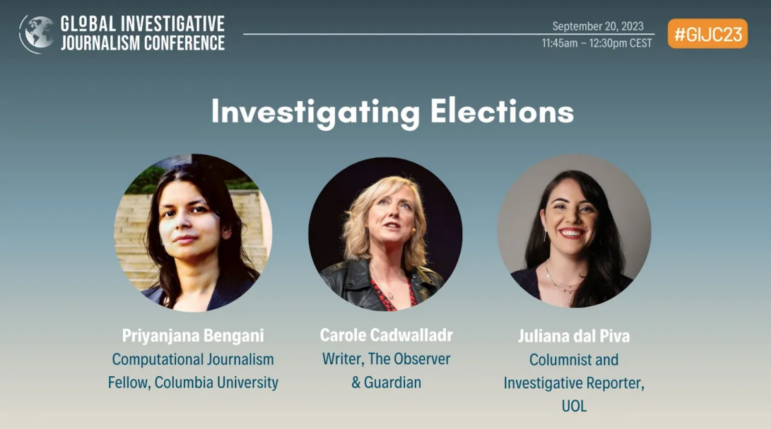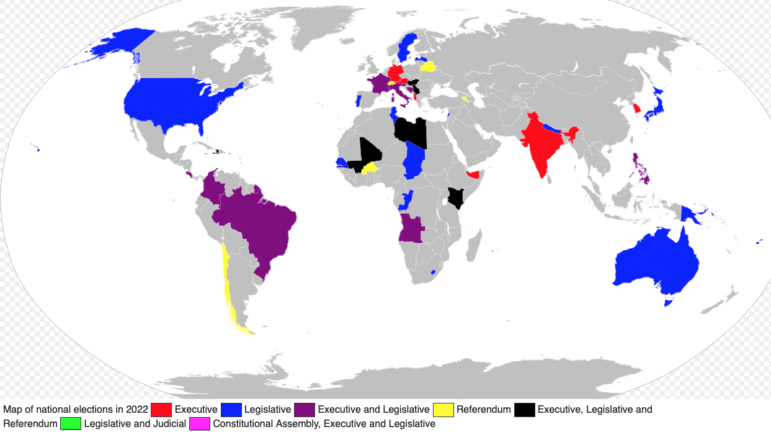

Illustration: Marcelle Louw for GIJN
Elections Guide for Investigative Reporters: Introduction
Read this article in
Guide Resource
GIJN’s Elections Guide for Investigative Reporters
Chapter Guide Resource
Elections Guide for Investigative Reporters: Introduction
Chapter Guide Resource
Elections Guide for Investigative Reporters: Chapter 1 — New Election Digging Tools
Chapter Guide Resource
Elections Guide for Investigative Reporters: Chapter 2 — Preparing for Elections
Chapter Guide Resource
Elections Guide for Investigative Reporters: Chapter 3 — Investigating Candidates
Chapter Guide Resource
Webinar: How to Investigate Elections
Chapter Guide Resource Video
GIJC23 – Investigating Elections
Elections around the world face increasingly common threats, including disinformation campaigns, foreign interference, voter suppression, rising authoritarianism, campaign corruption, minority disenfranchisement, and violence and intimidation.
Meanwhile, the state of democracy around the world is at its lowest point this century, as ‘elected autocrats’ consolidate their power through corrupt alliances with oligarchs and fellow authoritarians, misinformation is prioritized over facts by social media algorithms, and historically democratic governments use COVID-19 and xenophobic fears as pretexts for suppressing civil liberties and the press. And then, in February, a major Eastern European democracy – Ukraine – was brazenly attacked and invaded by Russia, an autocratic regime.
Traditional political coverage and the already overused horse-race approach are wholly inadequate for exposing and measuring election threats, or for tracking the bad actors behind them. Instead, independent media and watchdog journalists need to dig beneath the surface of increasingly precarious elections, while also protecting their information, themselves, and free expression itself from multi-pronged assaults by anti-democratic interests. To do this, they require courage, planning, collaborative support, courageous human sources, and new, innovative tools to deal with these threats.
Significant national elections in 2022 include those in Hungary, France, Serbia, Colombia, the Philippines, India, Kenya, Brazil, and the United States.
Following what many scholars called the “third wave of democratization” in the 1970s and ‘80s, researchers are now warning of a “third wave of autocratization,” in which authoritarian leaders learn tactics from each other to erode democratic institutions, enact repressive laws, outsource violence and intimidation, and control or pollute the information landscape. These same authoritarians can also create unfair playing fields for the opposition. For example, Hungarian Prime Minister Viktor Orbán — whose party, Fidesz, won parliamentary supermajorities in 2010 — has radically rewritten his country’s constitution, giving him and his party an easy path to rigging future elections in their favor. But research shows that even in countries where authoritarians eke out narrow election victories – as with Poland – democratic institutions can be gradually eroded, step by step, in a way that generates similarly drastic results. Investigative journalists can catch them in the act.
The Economist Intelligence Unit found in 2020 that 116 of the world’s 167 claimed democracies had declined in democratic health, and concluded that just one country – Taiwan – had made major positive strides. Even the one positive, widespread election trend found by researchers — notably stronger voter turnout in several countries during the past two years — had some chilling implications. As the NGO International Institute for Democracy and Electoral Assistance (International IDEA) observed, these same nations also featured the most toxic political polarization.
What You’ll Find in this Serialized Guide
While election rules and conditions are unique in every country, this GIJN guide is designed to offer a broad array of tools, techniques, and resources – beyond the primary local sources you find – to help watchdog reporters dig into almost any election. For instance, there are surprisingly simple online techniques for identifying and connecting people behind fear-mongering campaign sites, and open-source tools now exist that can capture all social media posts from violent election events, search political ads on Facebook; track police audio chatter; dig into extremist and anti-democratic social media channels; track illicit campaign financing; and automatically filter mountains of data.
In this ‘big picture’ introduction, we will preview the more technical, serialized chapters to follow each week; note some general election digging strategies to try; and highlight an example methodology for election scoops.
GIJN’s full, five-part guide to reporting on elections will be posted in its entirety later next month, incorporating this introduction and the following chapters.
Chapter 1: New Election Digging Tools
We asked leading journalists and elections experts around the world for the best new tools and techniques for reporters investigating elections in 2022 and beyond. In this chapter, we’ll do an in-depth exploration of our featured tool – an amazing, free, Swiss Army knife-like investigative weapon for tracking online election conversations and disinformation, with its own graphics. We’ll also feature another remarkably simple tool for identifying individuals behind election-related websites, which requires no digital skills more advanced than “Control-F” keyword search commands.
Chapter 2: Preparing for Elections
In this chapter, we’ll list tools and resources for understanding the rules of elections, and how to keep yourself, your sources, and your data safe, while finding leads and sources. We’ll also list election trends to investigate, including the increasingly popular “elected autocrats’ playbook.”
Chapter 3: Investigating Candidates
It’s important for reporters to assume they know nothing about politicians who stand for national office. Here, we share tools for uncovering candidates’ online histories, hidden assets, and contacts for people who really know them. We will also share a methodology for performing due diligence on candidates’ backgrounds, using a revealing Brazilian case study.
Chapter 4: Investigating Political Messaging and Disinformation
Where are influential election conversations actually happening? Who are the political ad donors and the disinformers, and how can they be identified? In this chapter, we’ll share step-by-step methods for digging into platforms like Telegram and Twitter, where citizens discuss everything from important policy issues to bizarre conspiracies to plots to violently overturn elections.
General Election-Digging Strategies to Consider
1. Find local tips and databases through citizen monitors.
Experts and GIJN member newsrooms that have dug into elections say that while effective databases and tools are essential, most consequential investigations begin with human sources. These include whistleblowers, law enforcement and civil society professionals, election managers, low-level campaign staffers – and, importantly, ordinary citizens who care about democracy.
Pat Merloe, director of electoral programs at the US government-funded National Democratic Institute, says a wealth of information is available to journalists from the hundreds of nonpartisan election monitoring groups around the world. NDI’s country-by-country database includes 251 vetted organizations in 89 countries. He says reliable groups are an underused resource for independent media, and that, crucially, they can also direct reporters to the up-to-date local election rules and datasets they’ll need to assess legal compliance by campaigns and supporters. As examples, Merloe cited the Christian Churches Monitoring Group (CCMG) of Zambia, which deployed 1,108 observers to Zambia’s 2021 presidential by-election, as well as The Young Lawyers Alliance and ISFED (International Society for Fair Elections) in Georgia.
“Some might be looking at election violence; some might be looking at disinformation; all would be looking at questions about the integrity of the voter lists, the locations of polling stations, the 10 things to watch out for on election day – these are the folks I’d reach out to,” says Merloe.
2. Report as if your country is a true democracy – even if it isn’t.
One important general strategy for covering elections in countries already gripped by authoritarian rule is, where possible, to report as if the country is a functioning democracy. In other words, pursue even those campaign corruption stories that will likely not result in arrests or firings or recorded voting changes, because, as Lina Attalah, chief editor of the Egyptian site Mada Masr, has pointed out, this approach helps prevent self-censorship, and keeps the bar high for voter expectations of public ethics.
3. Crowdsource evidence of election dirty tricks.
If your country’s election conversation is dominated by non-public messaging platforms like WhatsApp — especially in Southern Africa or Latin America – experts recommend that newsrooms publish a WhatsApp tip line number through the Google Voice app. Then, use that resource to enlist audiences to report any false election claims, voter registration dirty tricks, or extremist intimidation that they encounter. What’s more, experts recommend that rival newsrooms collaborate and use the same tip line number, working together to reveal anti-democratic misconduct and then tracing it back to the source.
This technique is also important for established democracies, especially for exploring disinformation robocalls. Tracing those responsible for calls falsely threatening added tax scrutiny for voters, or advising minorities to vote the day after election day, has, surprisingly, emerged as one of the toughest technical problems facing reporters. However, experts agree that crowdsourcing data from these calls is the best place to start.
4. Try simple Boolean Google searches, and repeat.
Advanced Boolean search tricks and “Google dorks” are powerful for narrowing online searches to the data you need. However, a striking takeaway from GIJN’s interviews with experts for this guide was how basic, rapid, and trial-and-error their digital searches tend to be. In fact, advanced open-source intelligence skills are rarely needed. For instance, we watched Nancy Watzman — an investigative journalist and consultant to New York University’s Cybersecurity for Democracy project — run Google searches for plots of voter intimidation, and, most of the time, she simply used alternating, carefully thought-out keywords along with the basic terms AND and OR in the same Google search bar that we all use.
- Here is one such example of simple Google searches from Watzman’s digital reporter’s notebook. After the January 6 riot at the US Capitol in 2021, she used a series of paired terms to check for threats of violence to the inauguration of President Joe Biden on January 20: “patriot” AND (“march” OR “rally” OR “january 20” OR “jan 20” OR “fraudulent election” OR “ashli babbit” OR “storm” OR “capital” OR “capitol”) “inauguration” AND (“march” OR “rally” OR “storm” OR “fraud”).
Google itself, Watzman says, is immensely powerful for election digging – if we think in terms of the way the search engine, and the people we’re investigating, tend to think, and just keep trying.
5. Manage voter expectations.
The role of investigative reporters should not only involve accountability and wrongdoing in elections, but also effective public service journalism that underlines the truth of the facts reported, and the legitimacy of elections. This includes visualizations – with excellent open-source tools like Flourish – to counter false fraud claims, foster newsroom collaboration, and set voter expectations for normal delays and typical errors in election counts. Experts also recommend clear “Why we did it” story explainers to promote media trust in politically polarized countries. Lynn Walsh, assistant director at Trusting News, suggests that reporters embed “Why/How we reported this” boxes prominently in the body of investigative election stories, and that they consider candid, first-person video clip explainers by the reporter as well.
RISE Moldova Case Study: A Methodology for Election Scoops
Reliable global and local databases are excellent resources for triggering new questions, finding connections, and checking facts. We will share several useful datasets in subsequent chapters of this guide.
However, Vladimir Thorik, Russian-language editor of the investigative outlet RISE Moldova – a GIJN member and Eastern European affiliate of the Organized Crime and Corruption Reporting Project (OCCRP) – emphasizes that most major scoops about election misconduct begin with human sources or leaks, and end with a combination of database mining, social media searches, and open source tools.
In 2020, Thorik and his team’s “Kremlinovici” investigation followed just such a path. It began, he says, with a leak from an anonymous source who respected RISE Moldova’s prior in-depth election reporting. This initial leak was followed by interviews with developed sources, and verified via a database known as the Chernov Archives, as well as by collaborative reporting with the Russian Dossier Center.
Thanks to this comprehensive process, RISE Moldova exposed close links and coordination between the re-election campaign of Moldova’s then-president and Russian intelligence services. In addition, it documented violations of election laws, found several business links between the president’s family and Russian corporations, and identified eight mysterious visitors to the presidency and ruling party headquarters as “election technology advisers” that had been dispatched from the Kremlin. RISE Moldova even showed how some domestic speeches and campaign slogans were cooked up in a secretive Russian foreign influence unit.
Thorik’s series represents a useful case study to follow for election scoops. It includes tips like:
- Develop human sources around campaigns, civil society organizations, and law enforcement.
- Investigate candidates’ financial and political connections, using social media and databases like OpenCorporates and Aleph. RISE Moldova used the Chernov Archives database, leaked from Russian sources.
- Identify election threats — such as Russian interference, in this case — flagged by your sources, and actively search for signs of anti-democratic assault.
- Attract leaks from whistleblowers with consistently courageous political reporting, and offer tipsters more confidence by using encrypted channels like Protonmail for documents, and Signal for communications.
- Employ social media search tools to learn the political conversations, misinformation, and potential impacts triggered by the action you’re investigating.
- Collaborate with newsrooms and nonprofits that have better sources or deeper insights into the troubling influencers you uncover. RISE Moldova collaborated with the Russian Dossier Center to dig into the Kremlin department responsible for influencing foreign elections.
- Train yourself on election rules — Moldovan law, and the Central Electoral Commission, in this case — and check for possible rules violations.
- Hit the streets to conduct in-person interviews. and note any possible inside sources close to the campaigns at rallies and public events – including drivers, cooks, and campaign photographers. Take photographs of unfamiliar faces interacting with campaign staff for later analysis.
- Use open source tools to identify and track the protagonists. Thorik’s team used tools like PimEyes and Findclone to identify outside “election consultants” whom their sources didn’t recognize.
- Call on experts and data analysis to demonstrate how that misconduct may have altered the election, or how similar tactics distorted previous elections in other countries.
“For a big revelation in an election, you need primary information that you can’t find in any database, which means well-placed human sources or a leak,” Thorik explains. “But you do need those databases to fact check and dig further, and tools to zero in on individuals.” For instance, the initial tip Thorik received revealed the online username “Kremlinovici” that Moldova’s then-president used for strategic communications, which then guided the RISE Moldova team’s targeted online searches.
But how should leaked materials get into reporters’ hands? “Personal transfer of leaks is good because it eliminates a digital trail,” Thorik advises. “But I recommend not receiving leaks yourself, in person, but rather through an intermediary, as direct contact could endanger the source.”
Besides revealing alarming foreign meddling on behalf of a pro-Russian candidate, Thorik’s investigation also proved that Moldovan laws were violated because outside consultants hadn’t registered with the Central Electoral Commission. He also showed how the campaign tactics of the incumbent changed drastically in the wake of that Russian advice.
Additional Resources
Focus on the Risks to Democracy: Lessons from Abroad for US Election Coverage
Essential Resources for the US Election: A Field Guide for Journalists on the Frontlines
How Open Source Experts Identified the US Capitol Rioters
 Rowan Philp is a reporter for GIJN. He was formerly chief reporter for South Africa’s Sunday Times. As a foreign correspondent, he has reported on news, politics, corruption, and conflict from more than two dozen countries around the world.
Rowan Philp is a reporter for GIJN. He was formerly chief reporter for South Africa’s Sunday Times. As a foreign correspondent, he has reported on news, politics, corruption, and conflict from more than two dozen countries around the world.


















